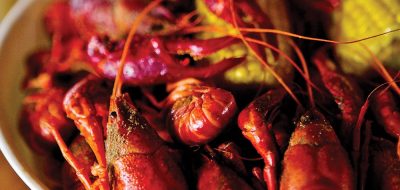Philadelphia might have the cheese-steak sandwich. New York may boast of its pizza, and Texas has BBQ—but Southwest Louisiana has boudin, and eating it guarantees a tingling palate and a full stomach.
In many homes, boudin is more revered than crawfish, with recipes passed along for generations.
Chances are, if you don’t live in or around Louisiana you haven’t heard of boudin.
Boudin, a sausage made with pork, rice, and seasonings is generally considered the signature food of Acadiana and other rural parts of southwestern Louisiana.
The pronunciation is a bit awkward. Visitors often say “boo-DIN” or “bow-DIN”.
The locals say “boo-DAN”.
If you’re having trouble with the pronunciation, just ask for a link. Most locals use that colloquial term, anyway.
I had my first taste of boudin last winter and I am seriously hooked.
History of Boudin
Boudin is a culinary gift from the French Acadians (Cajuns) who settled in southern Louisiana after their exile by the British from the Maritime Provinces of Canada beginning in 1755.
Boudin’s roots date centuries ago to France, where boudin is made with veal, chicken, cream, and Cognac.
Years ago, Cajun families would get together to slaughter a hog, an event known as a boucherie. The families left nothing to waste, so boudin was made with the leftover parts of the animal.
When French settlers’ recipes combined with German immigrants’ sausage-making skills and the area’s developing rice production, boudin as we know it today began to take shape.
What is Boudin?
Boudin is one of most unique, tasty, and distinctly uncorrupted regional specialties in America.
Basically, boudin is a combination of ground pork, liver, cooked rice, green onions, peppers, parsley, salt, black pepper, cayenne pepper, garlic powder, and other seasonings that vary from cook to cook.
The mixture is pulverized (to some degree) in a meat grinder before being stuffed into a sausage casing. It is then steamed, boiled, fried, grilled, or smoked—or otherwise heated—for on-the-spot snacking. Ahh, but these are truly just the basics.
The sausages’ moisture, coarseness of the stuffing, stiffness of the casing, and the meat-to-rice ratio vary.
In recent years many boudin producers have become creative by using shrimp, crawfish, seafood, chicken, and alligator to mix with the rice that is eventually stuffed into natural casings.
Ask five boudin specialists the key to success, and chances are you’ll get five answers: seasoning, consistency, texture, meat-to-rice ratio, and faithfulness to the recipe. Just don’t expect to learn the ingredients. Boudin recipes are a point of pride and closely guarded secrets.
There are some decent commercial brands of boudin available at chain grocery stores, but your best is always homemade. Local meat shops, butcher blocks, lunch places, gas stations, and independent grocers are the places where you can find the good stuff. When in doubt, ask if they make it themselves.
Ask any local and they’ll tell you where to get the best boudin — and it’s unlikely you’ll get the same answer twice.
The soft, squishy sausage is sold by the link, but priced by the pound.
It’s wrapped in butcher paper and often eaten as a to-go breakfast or snack somewhere between the counter and the parking lot. Boudin is the original slow, fast food.
The devotion to boudin results in innumerable other uses, recipe tweaks, or preparations for the meat and rice mixture. Boudin balls and smoked boudin are just two of the variations you’re likely to find. Boudin balls are made by rounding the sausage filling into balls and then breading and deep-frying it.
Caution: Boudin balls are addictive.
I’ve yet to get my fill of boudin.
For information about RV parks and campgrounds, check out Good Sam Guide Series.
Worth Pondering…
Food is a tie that binds, a constant, an equalizer, or in the words of James Beard: “Food is our common ground, a universal experience.”
If you enjoy these articles and want to read more on RV travels and lifestyle, visit my website: Vogel Talks RVing.





